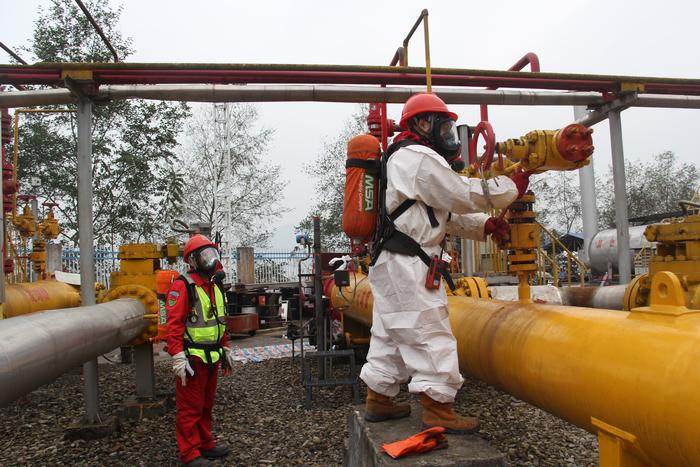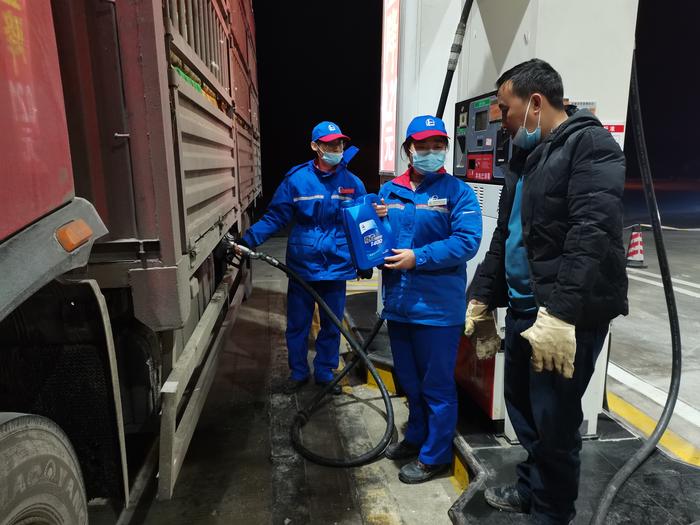|
| 2020-12-31 来源: 中国石化新闻网 |
| 石化新闻 |
中国石化新闻网讯 据今日油价12月28日报道,过去几周,原油期货价格一直在小幅走高,这与圣诞节假期前通常出现的获利回吐趋势背道而驰。西德克萨斯中质原油(WTI)上周五的交易价格一度高达每桶49.20美元,布伦特原油报价为每桶52.40美元,这是在2月份油价暴跌前达到的水平。 当然,目前多数交易员面临的最大问题是,本轮反弹能否持续到节日期间,甚至是更长的时间。从纯数据分析角度来看,原油价格自4月份以来一直在周线图上创下新高。最近一次触顶是在12月10日,纽约商品交易所(NYMEX)期货价格预计将在每桶50美元左右的心理关口附近触顶。下一个阻力位是2月中旬每桶54.50美元的高点,以及2020年每桶65.65美元的高点。 石油和天然气基准——能源精选板块SPDR基金(XLE)在过去30天上涨了12%,而标准普尔500指数上涨了4%。以下是看好石油市场的三个关键原因。 一是新冠肺炎疫苗可能会大量上市的利好消息促使能源行业在过去几周表现优异。 上周,辉瑞生物技术公司BNT162b2疫苗在美国首次亮相。几天前,疫苗来到了长期护理机构中,沃尔格林希望疫苗能够到3.5万个长期护理机构的近300万居民和员工手中。到目前为止,只有两个人被报道,称对疫苗有严重过敏反应,他们都是中年卫生工作者。然而,卫生专家表示,疫苗对公众来说仍然是安全的。 迄今为止的疫苗发展轨迹表明,大多数美国公众可能在明年2月底之前已获接种疫苗,这个消息好于Warp Speed行动负责人Moncef Sloui博士早些时候预测的人口目标的三分之一。 与此同时,欧盟将于2020年12月27日推出其疫苗接种计划。几天前,Moderna公司宣布,欧盟委员会已经行使了额外购买8000万支新冠肺炎疫苗的选择权,将该公司的总订单数扩大到1.6亿剂。 该计划初期就获得了成功,这给石油市场增添了大量乐观情绪,甚至保守的BP也开始改变之前的预测,认为石油需求可能要到2030年左右才会达到峰值。 二是全球经济似乎正在以超出预期的速度从新冠肺炎疫情中复苏。 事实上,美国和其他经济体的一些行业已经恢复到了疫情爆发前的活动水平,而经济快速复苏的一个关键原因是,史无前例的刺激计划的施行。 在世界卫生组织宣布新冠肺炎疫情为全球范围内的疫情后不久,各国政府推出了大规模的货币和财政刺激措施(全球规模超过15万亿美元),以防止经济受到毁灭性的冲击。美国联邦政府采取了一系列措施对经济进行干预,其中包括旨在支持金融市场、州和地方政府、雇主和家庭的2.3万亿美元一揽子计划。 美国国会周日终于就另一项9000亿美元的纾困计划达成协议。此前,国会通过了一项为期两天的延长拨款计划,使各机构得以在周日晚间继续运转,从而勉强避免了上周五政府关门的局面。周一晚上,国会就新的经济刺激方案进行了投票,并获得通过。 来自不同领域的分析师警告称,一揽子计划可能会反过来对市场产生不利影响。《纽约时报》畅销书作者、“捕熊报告”创始人劳伦斯 拉里 麦克唐纳(Lawrence 'Larry ' McDonald)警告人们注意,旨在拯救经济的刺激措施将“导致恶性通胀的经济崩溃”,从而引发“眼镜蛇效应”。 然而,事实证明,政府刺激计划是一种有效的工具,至少在短期内是有效的。 三是欧佩克+达成减产协议,缓慢增加供应。 两周前,欧佩克+成员国开会讨论了未来的石油生产计划,且当前的减产规模将在年底结束。 看涨人士希望,欧佩克+把目前770万桶的减产规模至少再延长3个月。当欧佩克+宣布将从1月份开始增加50万桶/天的产量后,他们受到了不小的冲击,这实际上是将2021年初的减产量降低到了720万桶/天。 不过令人惊讶的是,自声明宣布以来,油价在出现首次下跌后继续上涨。一位能源分析师解释了原因:“1月份原油日产量达到50万桶并不是市场担心的噩梦,但也没有达到几周前人们真正预期的水平。”Rystad Energy高级石油市场分析师Paola Rodriguez Masiu表示:“目前市场反应积极,价格小幅上涨,因为每天50万的额外供应对供求平衡的影响并不是致命的。” 换句话说,市场很高兴看到这23个成员国对其石油供应表现出谨慎态度。而另一个令人鼓舞的迹象是,世界上两大石油生产国——沙特阿拉伯和俄罗斯,这一次似乎站在了同一条战线上。 由于4月份油价暴跌的惨痛教训仍记忆犹新,欧佩克+不太可能冒着再次使市场受到猛烈打击的风险,很快地恢复无限制的石油供应份额和价格战。 王佳晶 摘译 今日油价 原文如下: 3 Reasons Why Oil Could See An End Of Year Rally Crude oil futures have been edging higher over the past few weeks, defying the usual trend of profit-taking ahead of the Christmas holidays. WTI was trading as high as $49.20 on Friday's session with Brent crude quoted at $52.40, levels they last touched in February before the oil price crash. Naturally, the big question for most traders at this point is whether this rally has the legs to continue into the festive period and even beyond. On a purely technical basis, crude oil has been making higher highs on the weekly charts since April. The latest peak came on Dec. 10 with the next expected around the psychological $50 level on NYMEX futures. The next technical resistance levels are at the mid-February high of $54.50 as well as the 2020 peak of $65.65. The oil and gas benchmark, Energy Select Sector SPDR Fund (XLE), has gained 12% over the past 30 days compared to a 4% gain by the S&P 500. Here are three key reasons why we remain bullish about the oil market. #1. Covid-19 Vaccines A big reason why the energy sector ranks has emerged as the best performer over the past few weeks is a flurry of potential Covid-19 vaccines becoming available. The rollout of the Pfizer-BioNTech mRNA-based vaccine BNT162b2 kicked off in the United States last week. The vaccine reached long-term care facilities a few days ago with Walgreens looking to expand the program to nearly 3M residents and staff at 35,000 long-term care facilities. So far, only two people have been reported to have recorded severe allergic reactions to the vaccine, both middle-aged health workers. However, health experts have sent ressurances that the vaccine is still safe for the general public. The vaccine trajectory so far suggests that the majority of the American public are likely to have received the vaccine by the end of February, better than the one-third of the population target that Dr. Moncef Slaoui, head of Operation Warp Speed, had earlier projected. Meanwhile, the EU is set to rollout its vaccination program on December 27, 2020. A few days ago, Moderna Inc. announced that the European Commission had exercised its option to purchase an additional 80M of its COVID-19 vaccine candidate, expanding the company's total order commitment to 160M doses. The early success of the rollout programs has instilled plenty of optimism into the oil markets with even conservative BP Plc (NYSE:BP) backtracking on its earlier projections that we might have passed peak oil with the company now saying oil demand might not peak till around 2030. #2. Stimulus Package After all the predictions of doom and gloom, the global economy appears to be recovering from the devastating pandemic at a faster-than-expected clip. Indeed, a handful of sectors of the U.S. and other economies have actually bounced back to pre-crisis levels of activity. A key reason for the fast recovery: Unprecedented stimulus packages. Shortly after the World Health Organization (WHO) declared Covid-19 a global pandemic, governments everywhere unveiled massive monetary and fiscal stimuli (over $15T globally) in a bid to forestall an economic fallout. The U.S. federal government stepped in with a broad array of measures, including a $2.3 trillion package designed to support financial markets, state and local governments, employers, and households. Congressional leaders finally reached a deal on another $900 billion aid package on Sunday, after managing to narrowly avoid a government shutdown on Friday by passing a two-day extension of funding that kept agencies running through Sunday night. Congress voted on the new stimulus on Monday evening and it passed. A cross-section of analysts have warned that the generous packages could come back to bite the markets. New York Times bestselling author and founder of 'The Bear Traps Report' Lawrence 'Larry’ McDonald has warned of the ‘cobra effect’ whereby the stimuli designed to save the economy will instead ‘‘...cause a hyperinflationary economic collapse.’’ Nevertheless, government stimulus has proven to be an effective tool, at least in the short-term. #3. OPEC+ Agreement Two weeks ago, OPEC+ members met to discuss future production plans with the current production cuts set to lapse at the end of the year. The bulls were hoping that the oil-producing cartel was going to extend the current production cuts of 7.7 million barrels per day for at least another three months. Instead, they received quite a jolt after OPEC+ announced that it will increase production by 500,000 barrels per day beginning in January, effectively lowering total production cuts at the start of 2021 to 7.2 million bpd. Surprisingly, oil prices have continued to rally since the announcement after an initial dip. One energy analysts explains why: “500,000 bpd from January is not the nightmare scenario that the market feared, but it is not what was really expected weeks ago. Markets are now reacting positively and prices are recording a small increase as 500,000 of extra supply is not deadly for balances,” Rystad Energy senior oil markets analyst Paola Rodriguez Masiu has declared. In other words, the market is happy that the 23-member organization appears to be exercising caution with its production. Another encouraging sign: Leading protagonists, Saudi Arabia and Russia, appear to be reading from the same page this time around. With the harsh lessons of the April oil price crash still fresh in its mind, it’s unlikely that OPEC+ will revert to senseless market share and price wars any time soon and therefore risk tanking the markets again. |








